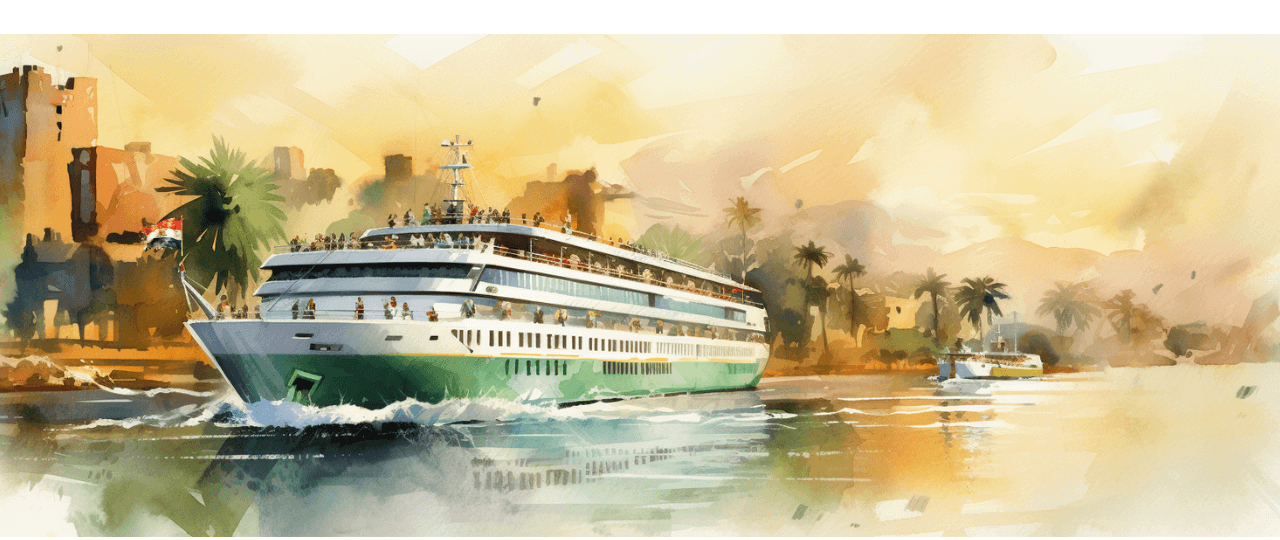The Nile, the world’s longest river, has been the lifeblood of Egypt since ancient times. Spanning over 4,000 miles, its waters have whispered tales of pharaohs, monuments, and civilizations that once thrived on its banks. It’s not just a river; it’s a chronicle of Egypt’s ever-evolving history.
Nile’s Rich Tapestry of History
From the time of the pharaohs to the modern-day, the Nile has been the centerpiece of Egyptian life. Ancient civilizations relied on its fertile banks, leading to the birth of the mighty Egyptian dynasties. Iconic structures like the pyramids of Giza and Luxor’s vast temple complexes stand as testaments to the river’s significance.
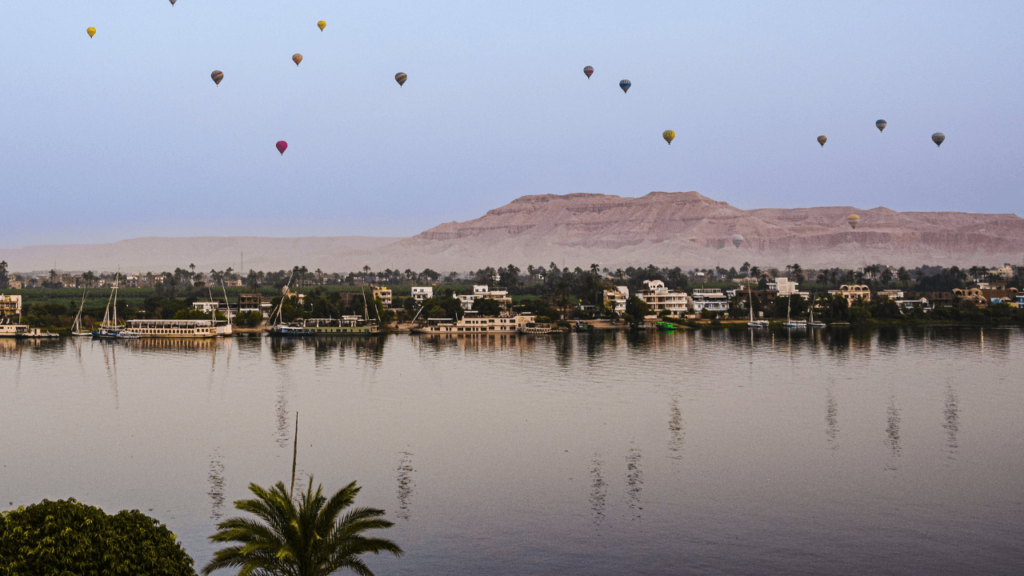
Nile Cruise: Egypt’s Tourism Jewel
Fast forward to today, and the Nile retains its magnetism, especially in tourism. Nile cruises offer travelers a unique vantage point to experience Egypt. These journeys provide an intimate look at the country’s archaeological wonders while floating past its ever-changing landscapes. For many, a Nile cruise isn’t just a trip; it’s a voyage back in time.
Taking a Nile cruise means more than just sightseeing. It’s about reliving the stories, feeling the pulse of ancient rituals, and understanding why Egypt has been a focal point of fascination for centuries.
Why Take a Nile Cruise?
Stepping onto a Nile cruise is akin to boarding a floating time capsule. But why is this journey touted as a must-have experience when visiting Egypt? Here’s why:
Witness Ancient History Firsthand
As you drift along the Nile, you follow the route ancient Egyptians once navigated. The awe-inspiring temples of Luxor and Karnak, the mystique of the Valley of the Kings, and the intricate tales carved on tomb walls are not just sites; they are storytellers waiting to share stories of dynasties long gone.
Sweeping Landscapes and Scenic Vistas
Picture this: sipping your morning tea as the sun rises over age-old palm groves, golden dunes, and local villages. The Nile offers an ever-changing canvas of Egypt’s natural beauty, a sight you won’t tire of.
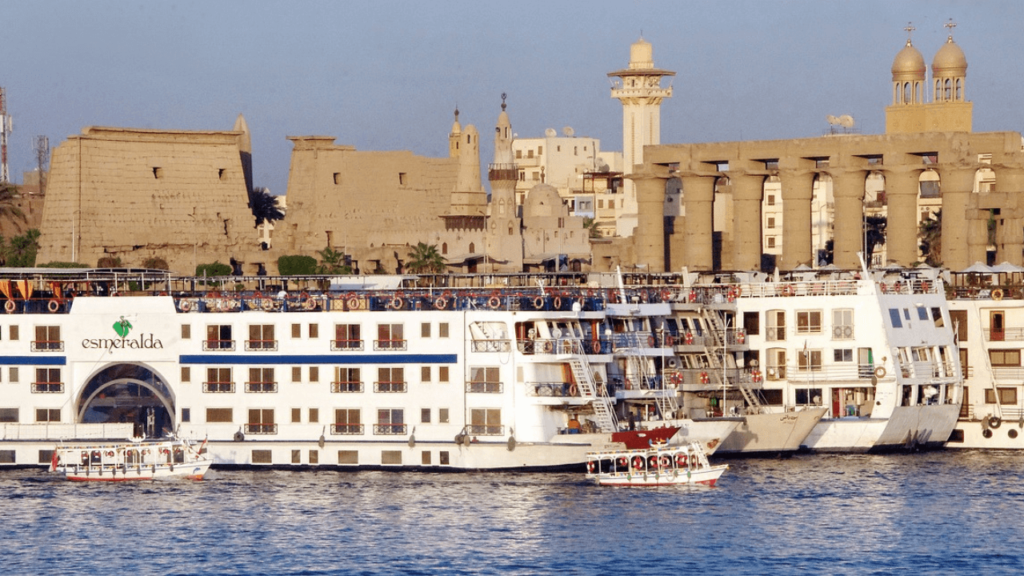
Dive Deep into Egypt’s Culture
Engage with local boatmen singing traditional songs, savor authentic Egyptian cuisine, and perhaps even learn a step or two of the local dance. A Nile cruise isn’t just about sightseeing; it’s about feeling the heartbeat of Egyptian culture.
Travel in Comfort and Elegance
Forget the hassle of packing and unpacking as you move from one city to another. Your Nile Cruiser is both a luxurious hotel and a mode of transport. With top-notch amenities and services, you’ve ensured a journey that marries comfort with the allure of exploration.
A Nile cruise is not merely a trip; it’s an experience that seamlessly blends history, beauty, culture, and luxury. For those seeking to understand Egypt beyond the guidebooks, this journey promises insights and memories that last a lifetime.
Best Time to Go on Nile Cruise
Egypt beckons travelers year-round with its timeless monuments and the serpentine Nile. But when is the ideal moment to embark on a Nile cruise?
Deciphering Egypt’s Climate
Egypt boasts a desert climate, meaning hot days and cooler nights. While summers (May to August) can be scorching with temperatures often exceeding 100°F (37°C), winters (November to February) are milder with daytime temperatures around 68°F to 79°F (20°C to 26°C).
Prime Time for Nile Cruising
Consider the months between October and April for a blend of pleasant weather and awe-inspiring sightseeing. The temperatures are agreeable, making temple explorations and deck lounging equally enjoyable. Due to the mild climate, December to February is especially popular, so booking in advance is wise.

The Allure of Off-Peak Cruising
Venturing on a Nile cruise during the shoulder (March to May and September to early October) or off-peak season (summer months) has its charms. Yes, it’s hotter, especially in the summer, but there are fewer tourists, granting a more private experience at major sights. Plus, prices can be significantly lower, making it a budget-friendly choice.
The Nile’s allure is undeniable year-round, but for the most agreeable weather, aim for the cooler months. If you’re on the hunt for tranquility and deals, the off-peak season is your hidden gem. Whatever your choice, the stories of pharaohs and the mesmerizing Nile landscapes await.
Here we have a complete guide for The Best time to visit Egypt!
Types of Nile Cruises
Sailing the Nile is a mesmerizing experience, and your chosen vessel can shape your journey. Among the most iconic is the Felucca, a testament to Egypt’s rich maritime history.
Traditional Feluccas: A Glimpse into the Past
Description and History
- Profile: Feluccas are traditional wooden sailboats, often characterized by large, triangular sails. Lacking motors, they are entirely wind-powered, making for a tranquil cruise.
- Origins: These boats have ancient roots, tracing back thousands of years. They’ve been employed for various purposes, from fishing to transporting goods, and have played a pivotal role in Nile life.
Advantages of Sailing on a Felucca
- Authentic Experience: Feluccas offer an unadulterated taste of the Nile, much as ancient Egyptians experienced it.
- Serenity: With no motor’s hum, it’s just the whisper of the wind, the gentle lapping of water, and bird calls.
- Affordability: Typically, Felucca rides are more budget-friendly compared to luxury cruises.
- Connection with Locals: Often crewed by local sailors, it’s a chance to engage in rich cultural exchanges.
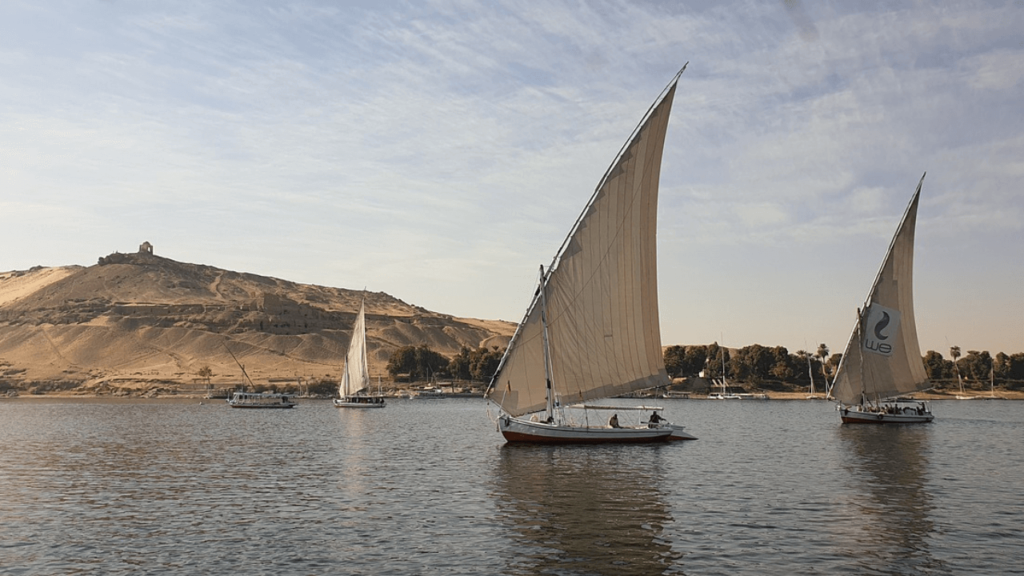
Disadvantages to Consider
- Basic Amenities: Feluccas are stripped of luxuries. Don’t expect en-suite bathrooms or gourmet meals. It’s a rustic experience.
- Weather Dependent: Being wind-powered means when there’s no breeze, there’s no movement. This can alter trip durations.
- Privacy: These open boats might not suit everyone, especially on multi-day journeys.
- Safety: While generally safe, they lack the advanced safety equipment found on larger vessels.
Choosing an intimate, authentic, and raw Nile experience is opting for a Felucca cruise. It’s a journey back in time, reminiscent of an Egypt untouched by modernity. But it’s essential to align expectations with the rustic nature of this voyage.
Standard Nile Cruise: Your Floating Hotel
Among the myriad ways to experience the Nile’s magic, the Standard Nile Cruise stands as a popular and accessible choice for many travelers. Let’s set sail to understand what this cruising option offers.
Description
- Profile: Standard Nile Cruises resemble floating hotels. Typically spanning 3 to 5 decks, these ships are equipped with various modern amenities, ensuring a comfortable journey as you navigate between ancient Egyptian wonders.
- Journey: Most standard cruises operate between Luxor and Aswan, with durations varying from 3 to 7 nights. The package often includes stops at key historical sites, guided tours, and onboard entertainment.
Advantages of Embarking on a Standard Nile Cruise
- Comfort and Convenience: Think of air-conditioned cabins, en-suite bathrooms, buffet meals, and sometimes even a pool on the deck. It’s a seamless blend of exploration and relaxation.
- Structured Itineraries: For those who prefer organized schedules, these cruises offer well-planned itineraries covering significant attractions.
- Budget-Friendly: While luxury options exist, standard cruises provide a more economical way to experience the Nile without skimping on essential comforts.
- Social Experience: With a larger number of passengers compared to smaller vessels, it’s an opportunity to meet fellow travelers worldwide.
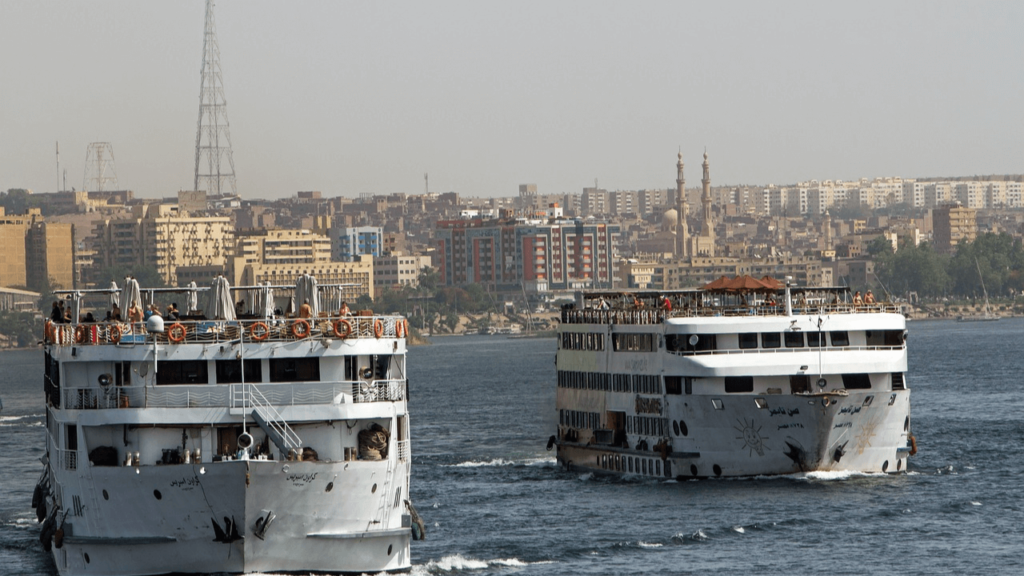
Considerations
- Less Personalized: Due to their size and the number of guests onboard, these cruises may lack the intimate feel of smaller vessels.
- Busier Schedules: Popular attractions can get crowded when multiple cruise groups arrive simultaneously.
- Less Authentic: Modern comforts come at the price of a more commercialized experience, which might detract from the raw, authentic feel some travelers seek.
A Standard Nile Cruise offers a comfortable, convenient, and often budget-friendly way to soak in Egypt’s rich history. While it might not provide the intimate authenticity of smaller vessels, it ensures a memorable and comfortable journey down the world’s longest river.
Luxury Cruisers: Sailing in the Lap of Opulence
Luxury Cruisers stand unparalleled when it comes to experiencing the Nile in grandeur. They promise a journey through ancient history, one shrouded in modern luxury comforts.
Amenities and Features of Luxury Cruisers
- Plush Accommodations: Expect spacious cabins with lavish furnishings, high-thread-count linens, and panoramic windows for uninterrupted river views.
- Gourmet Dining: These cruisers often boast multiple dining venues, from elegant main dining rooms to specialty restaurants, offering international and local delicacies.
- Wellness Facilities: Many luxury vessels feature spa centers, gyms, and sometimes even a jacuzzi or pool deck, ensuring guests can rejuvenate after a day of exploration.
- Entertainment: Evening entertainment can range from cultural dance performances to themed nights and sometimes lectures on Egyptian history.
- Guided Excursions: Exclusive guided tours with knowledgeable Egyptologists ensure in-depth insights into the landmarks visited.
- Personalized Service: With a high staff-to-guest ratio, expect personalized attention from butler services in suites to tailored dining experiences.
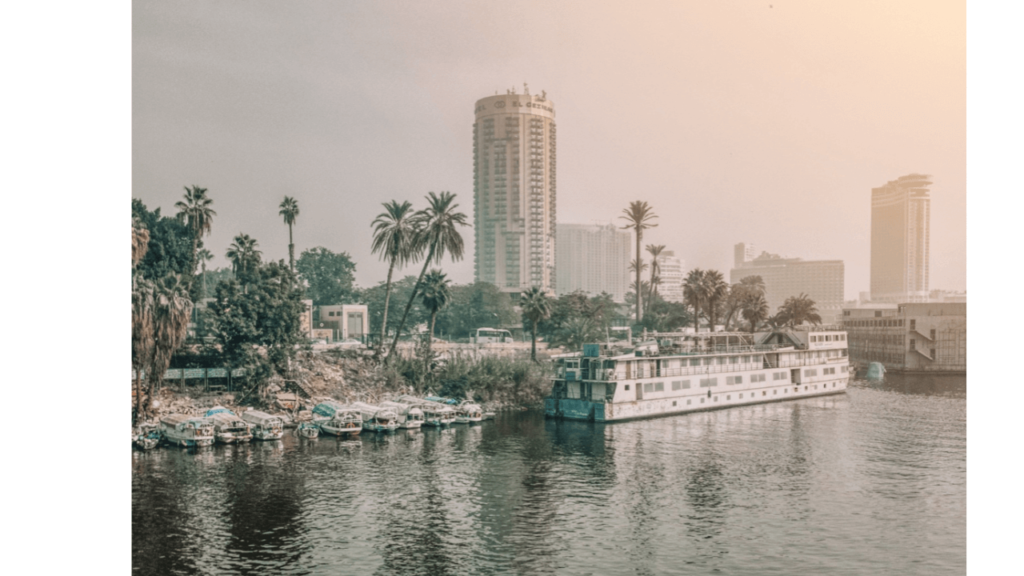
Price Range for Luxury Nile Cruises
- Starting Range: Prices can start from around $300 to $500 per person per night for a luxury experience.
- Mid-Range Luxury: Those seeking something more opulent, expect prices between $600 to $1,000 per person per night.
- Ultra-Luxury Experience: The crème de la crème of Nile cruises, offering unparalleled extravagance, can set travelers back anywhere from $1,200 to $3,000 (or more) per person per night.
It’s essential to note that prices vary based on the season, specific cruiser, journey duration, and the package’s inclusions.
A Luxury Nile Cruiser is for those who wish to traverse Egypt’s ancient wonders without compromising on modern luxuries. It’s a journey where past splendors meet the comforts of the present, offering an unforgettable experience.
Dahabiyas: Sailing the Nile in Time-Honored Elegance
The Nile, with its timeless allure, has been graced by various vessels over millennia. Yet, the Dahabiya stands out among its diverse flotilla, a blend of tradition and romance reminiscent of bygone eras.
Dahabiyas: A Glimpse into Their Storied Past and Uniqueness
History: The Dahabiya, translating to “golden one,” originates in the days of the pharaohs but gained prominence during the 19th and early 20th centuries. European travelers, artists, and writers of that era, seeking an intimate and leisurely Nile journey, often favored these boats.
Uniqueness: Unlike larger cruisers, Dahabiyas are wind-powered, relying primarily on their sails, though some modern versions might have backup engines. With a more elongated and narrower build, these boats typically accommodate fewer passengers, often ranging from 10 to 20.
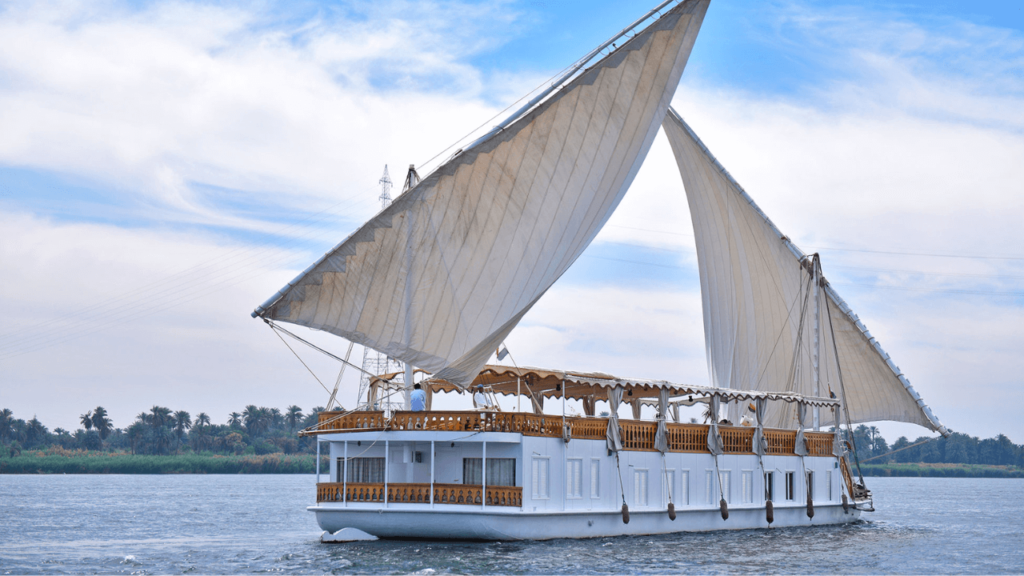
Photo Source: nile-dahabiya.com
Pros:
- Intimacy and Exclusivity: With fewer passengers, a journey on a Dahabiya feels private, making it perfect for those seeking solitude or traveling with a close-knit group.
- Authentic Experience: It’s a trip back in time, where the rhythms of the Nile dictate the pace, and evenings might be spent under starlit skies with traditional music.
- Off-the-Beaten-Path: The smaller size allows these boats to dock at less frequented sites, offering travelers unique experiences away from the typical tourist trail.
- Personalized Service: The limited number of guests ensures attentive service, often tailored to individual preferences.
Cons:
- Pace: Being wind-powered means they’re at the mercy of the breeze. Calm days might lead to slower progress, possibly altering itineraries.
- Amenities: While many Dahabiyas are luxurious, they might lack some of the extensive amenities found on larger cruisers, such as pools or gyms.
- Price: Due to their exclusivity and unique offerings, Dahabiyas can sometimes be more expensive than standard cruises.
For travelers yearning for an intimate, authentic, and unhurried experience, this traditional sailing boat promises memories that linger long after the journey ends.
Key Stops and Attractions on the Nile Cruise
Navigating the Nile on a cruise is more than just a journey; it’s a voyage through time. As you sail, the ancient wonders of Egypt unfold before you, and among them, Luxor stands as a testament to the nation’s unparalleled historical legacy. Let’s dive into some of its crown jewels.

Luxor: The Ancient Thebes
Often dubbed the “world’s greatest open-air museum,” Luxor was once the ancient city of Thebes, the thriving capital of Upper Egypt.
Highlights: Luxor’s temples and monuments are a gateway to some of Egypt’s most renowned archaeological treasures.
Traveler’s Tip: Allocate at least a couple of days to explore Luxor’s offerings, and if possible, catch a sunrise hot air balloon ride for a bird’s-eye view of this ancient city.
Valley of the Kings: The Royal Burial Grounds
Situated on Luxor’s West Bank, this valley is a sprawling cemetery hosting the tombs of pharaohs and nobles from Egypt’s New Kingdom era.
Highlights: Home to more than 60 tombs, including that of the famous boy king Tutankhamun. Each tomb is adorned with intricate carvings detailing rituals and the pharaoh’s journey to the afterlife.
Traveler’s Tip: The tomb entries often rotate to minimize wear and tear. It might be worth purchasing a multi-tomb ticket to maximize the experience and always consider hiring a guide for deeper insights.
Karnak Temple: The Monumental Religious Complex
Located in the northern end of Luxor, Karnak is not just a temple but a vast complex of sanctuaries, pylons, and obelisks dedicated to the Theban gods and the greater glory of Egypt’s pharaohs.

Highlights: The Great Hypostyle Hall, with its 134 massive columns, is a sight. The temple complex is interconnected with sacred lakes, statues, and sphinxes.
Traveler’s Tip: Visit during the evening for the sound and light show, where the temple comes alive with storytelling, painting the ancient structures in a play of light and shadows.
These attractions are but a glimpse into the rich tapestry of Egypt’s history. As you disembark at each location on your Nile cruise, remember you’re stepping into tales that span millennia, where every stone and glyph has a story waiting to be unraveled.
Aswan
As your Nile cruise reaches the southern frontier of ancient Egypt, Aswan emerges as an enchanting blend of Nubian culture, historical gems, and modern engineering feats. Here’s a peek into some of its iconic landmarks.
With its golden dunes, azure waters, and colorful Nubian villages, Aswan offers a serene contrast to the hustle of Egypt’s larger cities.

Highlights: Besides its historical attractions, Aswan is renowned for its bustling souks, the idyllic Elephantine Island, and the scent of spices wafting through its streets.
Traveler’s Tip: Consider spending an evening exploring the Nubian villages. Their vibrant houses, cultural music, and welcoming locals offer a delightful cultural immersion.
Philae Temple: The Relocated Wonder
Dedicated to the goddess Isis, this temple complex was painstakingly moved to its current location on Agilkia Island to save it from the rising waters of Lake Nasser.
Highlights:
The temple’s exquisite carvings depict tales of gods and pharaohs. Its architecture, with majestic towers and colonnades, is a testament to the prowess of Ptolemaic builders.

Traveler’s Tip: Time your visit for the evening sound and light show. As narratives echo across the temple, illuminations breathe life into these ancient stones, weaving tales of devotion and divinity.
The Aswan Dam: Engineering Marvel on the Nile
Divided into the older Low Dam and the more recent High Dam, this engineering marvel tamed the Nile’s annual floods, giving birth to Lake Nasser, one of the world’s largest artificial lakes.
Highlights
While the dam is a testament to modern engineering, its creation led to significant archaeological rescue missions, preserving numerous ancient sites from inundation.
Traveler’s Tip
Consider visiting the Nubia Museum before heading to the dam for a comprehensive understanding. It offers insights into the region’s history and the international efforts to save its monuments.
Aswan, with its tranquil allure, bridges epochs, connecting the ancient world’s grandeur with contemporary achievements. As you alight from your Nile cruise to explore its shores, prepare to be enchanted by tales that dance between eras, each more captivating than the last.
Kom Ombo: The Temple of Duality
As the Nile winds its course, it unveils stories etched in stone. Among its many tales, the temples of Kom Ombo and Edfu stand as exceptional chapters, narrating tales of gods, pharaohs, and ancient rituals. Here’s a brief exploration of these architectural marvels:
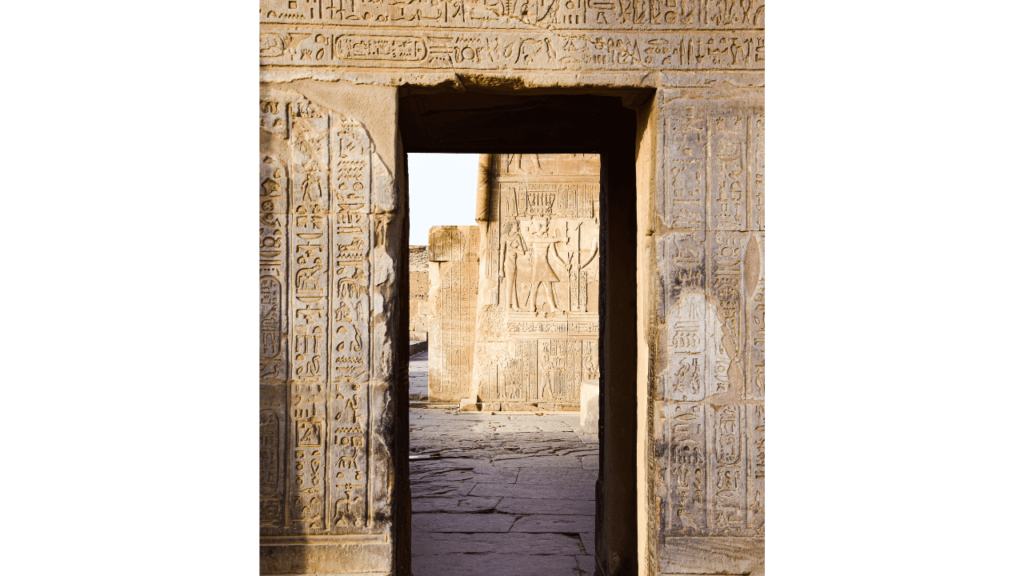
Strategically located overlooking the Nile, Kom Ombo is a unique ‘double’ temple dedicated to Sobek, the crocodile god, and Horus the Elder.
Highlights
The temple is symmetrically split, with each side mirroring the other, reflecting its dual dedication. Here, you’ll find intriguing crocodile mummies, offerings to Sobek, and detailed carvings showcasing surgical instruments hinting at ancient medical practices.
Traveler’s Tip
Visit in the evening, when the temple, illuminated against the night sky, casts a magical reflection on the Nile’s waters, amplifying its allure.
Edfu: The Falcon’s Abod
Edfu Temple is nestled between Luxor and Aswan and is dedicated to Horus, the Falcon god. It’s one of the best-preserved temples in Egypt, constructed during the Ptolemaic era.
Highlights
Beyond its grand pylons lies a labyrinth of chambers and courtyards. The walls narrate the epic battle between Horus and his nemesis, Seth. The inner sanctum, housing a statue of Horus, exudes an aura of reverence and mystery.
Traveler’s Tip
Arrive early to experience the temple in the soft morning light and to beat the crowds. Also, consider a horse carriage ride to the temple from Edfu town; it’s a delightful local experience.
In Conclusion, Both Kom Ombo and Edfu offer more than just architectural grandeur; they serve as windows into ancient beliefs, societal practices, and tales that have shaped millennia. As your Nile cruise docks at these sites, tread lightly and listen closely, for the stones beneath your feet have timeless tales to tell.
Abu Simbel
Far to the south, near the border of modern-day Sudan, lies one of ancient Egypt’s most awe-inspiring sites: Abu Simbel. Carved into solid rock and standing as colossal guardians to the south, these temples are a powerful testament to Pharaoh Ramses II’s ambition and the timeless allure of ancient Egypt.
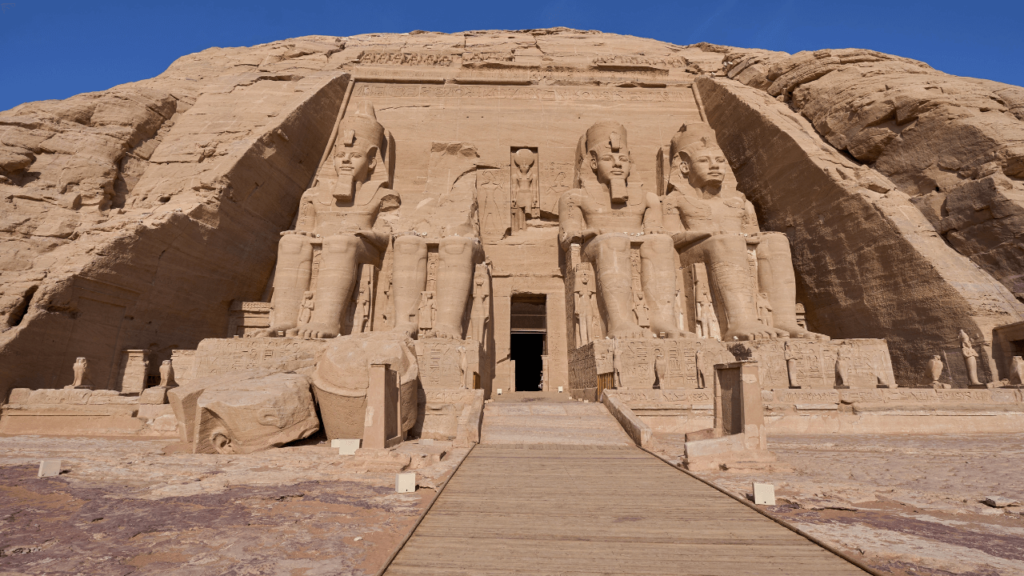
The Twin Temples of Grandeur
- The Great Temple of Ramses II
Dominated by four towering statues of Ramses II, this temple was both a dedication to the gods and a monument to the pharaoh’s own achievements.
Highlights
The inner sanctuary is aligned such that twice a year, sunlight illuminates the statues within, sparing only Ptah, the god of darkness. This phenomenon, known as the Sun Festival, draws thousands and is a spectacle to behold.
Traveler’s Tip
If possible, time your visit during the Sun Festival (typically February 22 and October 22) to witness this architectural marvel in all its illuminated glory.
- The Smaller Temple of Hathor:
Dedicated to the goddess Hathor and commemorating Nefertari, Ramses II’s chief consort, this temple stands as a rare ancient tribute to a queen.
Highlights
Six statues – four of Ramses and two of Nefertari – flank the entrance, with the latter being of equal size to the pharaoh, underscoring Nefertari’s significance.
Traveler’s Tip
Take time to appreciate the intricate wall carvings within, which detail the queen’s role in religious rituals and her esteemed position in the pharaoh’s life.
The Monumental Move
One of the 20th century’s most ambitious archaeological rescue missions occurred here. Threatened by the rising waters of Lake Nasser due to the Aswan High Dam’s construction, both temples were meticulously cut, moved, and reassembled on higher ground, ensuring their preservation for future generations.
Beyond its monumental facades, Abu Simbel tells tales of devotion, love, and humanity’s relentless quest to defy time. As you stand before its magnificence, be prepared to feel both humbled by its ancient grandeur and inspired by the feats of modern determination that saved it.
Duration of the Nile cruises
The mighty Nile, with its winding course and tales as old as time, offers travelers a spectrum of cruise durations to fit varied interests and schedules. From quick glimpses to extensive explorations, here’s a guide to help you decide the ideal length for your Nile journey.
Short Cruises (3-4 Days)
Typically covering the stretch between Luxor and Aswan, these cruises are perfect for those pressed for time but eager to witness the river’s primary attractions.
Highlights: Key stops often include the Valley of the Kings, Karnak and Luxor Temples, Kom Ombo, Edfu, and the Philae Temple in Aswan.
Traveler’s Tip: It is ideal for those combining the Nile experience with other Egyptian adventures, like the Red Sea or Cairo.
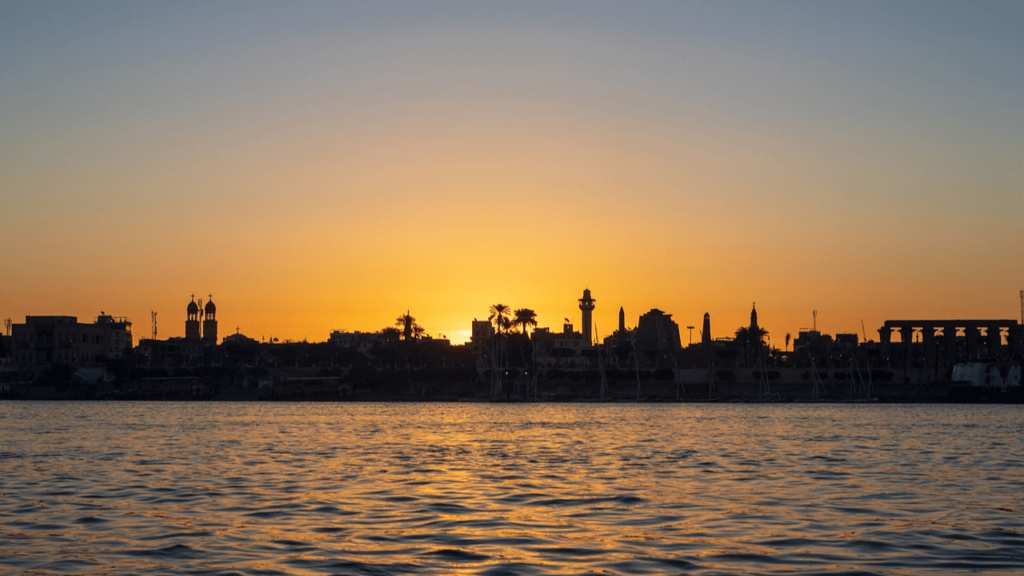
Standard Cruises (5-7 Days)
Offering a more leisurely pace, these cruises delve deeper into the wonders between Luxor and Aswan, with extended time at major sites and potential additional stops.
Highlights: Beyond the main attractions, travelers might enjoy more in-depth tours, local village visits, or even Nubian cultural experiences.
Traveler’s Tip: This duration strikes a balance, allowing relaxation on the cruise while ensuring comprehensive sightseeing.
Extended Cruises (8-15 Days)
These cruises span longer Nile sections, often starting from Cairo and culminating in Aswan or vice-versa.
Highlights: Besides the famed temples and tombs, travelers can explore lesser-visited sites like the Temple of Hathor at Dendera, the Middle Kingdom pyramids of Dahshur, and the ancient city of Abydos.
Traveler’s Tip: Opt for these if you’re a history enthusiast or if the Nile journey is your primary focus in Egypt.
Tailored & Specialty Cruises
Some cruises cater to specific interests – archaeology, photography, or culinary pursuits.
Highlights: Itineraries are crafted around themes, potentially featuring expert talks, workshops, or off-the-beaten-path excursions.
Traveler’s Tip: These can be of varied durations. It’s essential to research and find one that aligns with your passions.
Dining and Cuisine on a Nile Cruise
While the Nile Cruise whisks you through Egypt’s historic heart, the onboard dining experience ensures that your culinary journey is equally memorable. Here’s a look into the flavors and feasts that await:
Overview of Egyptian Cuisine
Egyptian cuisine is a symphony of flavors shaped by millennia of various cultural influences, from Pharaonic to Ottoman. It’s hearty, wholesome, and aromatic.
Highlights
Staple ingredients include legumes, rice, and bread, often seasoned with dill, garlic, coriander, and cumin. Lamb, chicken, and fish are common proteins, while vegetables like okra, eggplant, and lentils frequently grace the table.
Must-try Dishes Onboard
Koshari: Often dubbed Egypt’s national dish, it’s a savory mix of rice, lentils, chickpeas, and pasta topped with a tangy tomato sauce and crispy onions.
Molokhia: A rich, green soup made from finely chopped jute leaves, often cooked with chicken or rabbit and flavored with garlic and coriander.
Ful Medames: A delicious fava bean stew seasoned with olive oil, garlic, and lemon, typically enjoyed for breakfast but cherished any time of the day.

Grilled Fish: Drawing from the Nile’s bounty, fresh fish grilled to perfection with spices is a common and delightful dish to savor.
Umm Ali: For the sweet-toothed, this Egyptian bread pudding, made with layers of flaky pastry, milk, and nuts, promises a delectable end to meals.
Dietary Restrictions and Accommodations
Modern Nile Cruises understands the diverse dietary needs of global travelers and strives to cater to a range of preferences.
Highlights: Vegetarian, vegan, gluten-free, and halal options are typically available. It’s common to find a mix of international cuisines alongside local dishes, ensuring there’s something for every palate.
Traveler’s Tip: If you have specific dietary restrictions or allergies, it’s recommended to communicate these when booking. Cruise staff are usually very accommodating and can adjust meals accordingly.
Tips and Etiquette on the Nile Cruise
Beyond its historical allure, the Nile Cruise is also a voyage through the rich tapestry of Egyptian culture. As you embark on this journey, being aware of local customs and etiquette ensures a more enriching and respectful experience. Here’s a guide to help you tread thoughtfully:
Cultural Sensitivity
Local Interactions: Egyptians are known for their warmth and hospitality. A smile and a greeting, such as “Salam Alaikum” (Peace be upon you), can go a long way in fostering goodwill.
Religious Observances: Egypt is predominantly Muslim. You may witness the call to prayer five times a day. Respect these moments, and if possible, refrain from loud conversations or music during these times.
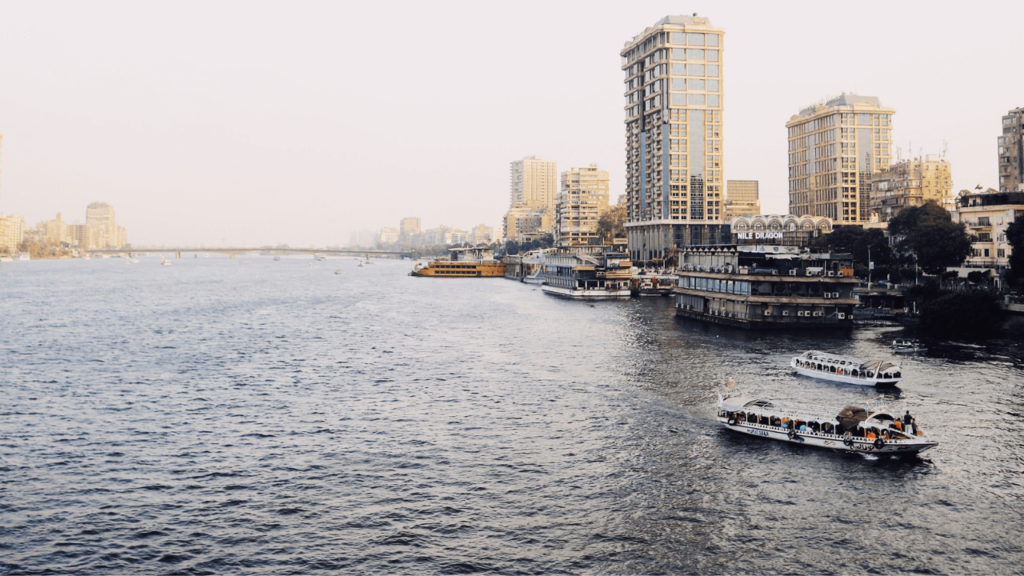
Tipping Customs
Baksheesh Culture: Tipping, or ‘baksheesh’ as it’s locally known, is an integral part of Egyptian culture. It’s a token of appreciation for the services rendered.
Guidelines: While it’s at your discretion, here’s a general idea:
- Housekeeping: Around 20-30 Egyptian Pounds (EGP) per day.
- Waitstaff: 10-15% of the bill unless a service charge is included.
- Cruise staff: Many travelers set aside a collective tip to be distributed among the crew, usually amounting to about 50-100 EGP per day of the cruise.
- Tour guides: 50-100 EGP per day, based on group size and satisfaction.
Dress Code on a Nile Cruise
Modesty Matters: Egypt values modesty, especially in rural areas and religious sites. It’s recommended to wear clothes that cover the shoulders and knees.
Onboard Attire: While the cruise atmosphere is more relaxed, consider lightweight, breathable clothing. Evening events might call for slightly dressier attire.
Footwear: Comfortable walking shoes are essential for excursions. However, on the cruise deck, sandals or flip-flops are suitable.
Swimwear: If your cruise has a pool, pack swimwear. However, reserve it for pool areas and avoid walking around the ship.
Safety and Health
The enchantment of a Nile Cruise is best enjoyed when health and safety are prioritized. While Egypt offers many experiences, being well-prepared ensures your journey remains a cherished memory. Here’s a guide to help you navigate these waters confidently:
Precautions to Consider
Travel Insurance: Before embarking, ensure you have comprehensive travel insurance that covers medical emergencies, trip cancellations, and potential evacuations.
Stay Hydrated: The Egyptian climate, particularly in summer, can be hot and dry. Drink plenty of bottled water, and avoid tap water unless it’s been boiled or treated.
Protect from the Sun: A wide-brimmed hat, sunglasses, and high-SPF sunscreen are essential. Opt for lightweight, long-sleeved clothing to shield against sunburn.
Vaccinations and Health Considerations
Recommended Vaccines: Consult with a travel clinic several weeks before your trip. While no vaccines are mandatory for entry into Egypt, recommended ones often include Hepatitis A, Typhoid, and Tetanus-Diphtheria.
Malaria: Malaria is generally not a concern in Egypt. However, always discuss the most up-to-date recommendations with your health professional.

Traveler’s Diarrhea: This can be a common ailment. Consider packing anti-diarrhea medication and oral rehydration salts. Consuming only well-cooked food, peeled fruits, and bottled water can minimize risks.
Prescriptions: If on medication, bring an adequate supply and keep them in their original packaging with clear labels.
Ensuring a Safe Cruise Experience
Stay Informed: Upon embarking, attend any safety briefings the cruise staff provides. Familiarize yourself with the ship’s layout, emergency exits, and evacuation procedures.
Respect Local Customs: When ashore, be mindful of local norms, dress codes, and behaviors. This not only shows respect but also ensures positive interactions.
Secure Valuables: While most Nile Cruises offer a high safety standard, it’s wise to utilize safes or lockboxes provided for valuables and travel documents.
Local Guides: If exploring independently when docked, consider hiring a reputable local guide. They can enhance your experience and help you navigate potential safety concerns.
Safety doesn’t happen by accident; it’s a sum of wise choices. By being proactive, you ensure that the stories you bring back from the Nile are only of adventure, beauty, and the whispers of ancient pharaohs.
Booking Your Nile Cruise
The allure of the Nile, with its temples, tombs, and timeless landscapes, is undeniable. But a critical step awaits before you float down this iconic river: booking the right cruise. Here’s a guide to help you navigate this process, ensuring your Nile experience is magical.
Where to Book: Online vs. Travel Agencies
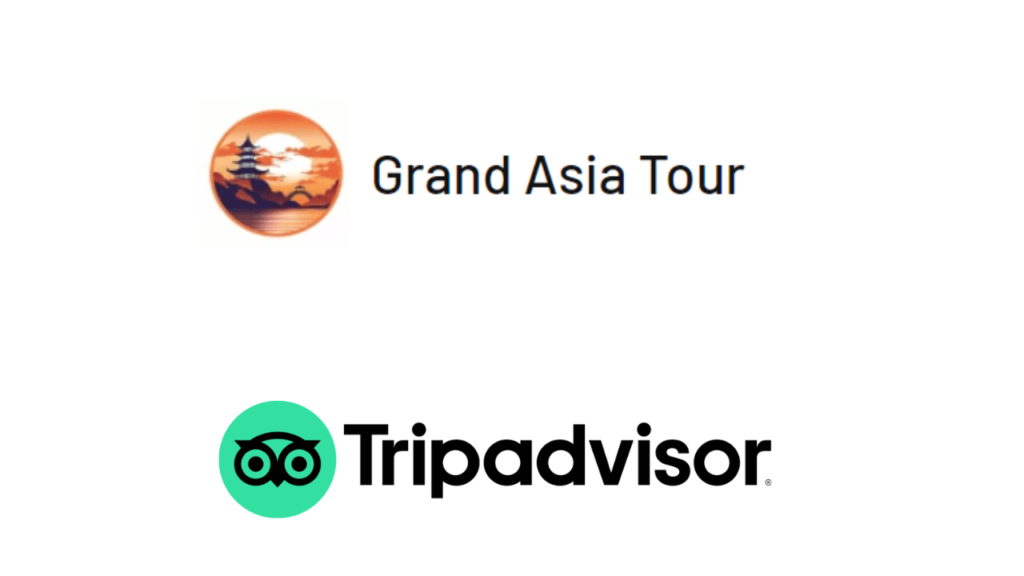
Online Platforms
Pros: They offer the convenience of browsing multiple options from the comfort of your home. Price comparisons, instant bookings, and virtual tours of ships are often available.
Cons: Overwhelming choices, and sometimes, the reality might slightly differ from the polished online presentation.
Traveler’s Tip: Websites like TripAdvisor, Booking.com, or specialized platforms focused on Egyptian tourism often provide real traveler photos and reviews.
Travel Agencies
- Pros: Personalized advice, potential package deals including flights or additional tours, and the assurance of dealing with a human who understands your unique needs.
- Cons: It might be slightly more expensive due to agency commissions.
- Traveler’s Experience: Many travelers appreciate the tailored approach of agencies, especially if visiting Egypt for the first time. The added value of their expertise often outweighs the extra cost.
Deciding on Cruise Length: Short vs. Long Cruises
Whether you choose a short or long Nile Cruise often hinges on three critical factors:
Budget: Short cruises are generally more budget-friendly, offering a snapshot of the Nile’s splendors. Longer cruises, while more expensive, provide an in-depth exploration and might include more luxurious amenities and services.
Places you want to Visit: If you have specific sites or cities in mind, this can influence your decision. Short cruises typically cover the main highlights, while longer ones can introduce you to off-the-beaten-path attractions.
Time Available: Your overall travel itinerary in Egypt plays a role. If the Nile Cruise is a centerpiece of your trip, a longer duration might be more fulfilling. However, a shorter voyage may fit better if you combine the cruise with other Egyptian adventures.
Evaluating Cruise Providers: Ratings, Reviews, and Reputation
Ratings & Reviews: Platforms like TripAdvisor, Google Reviews, or Cruise Critic provide invaluable insights from fellow travelers. Look for consistent themes in feedback, both positive and negative.

Reputation: Established cruise providers with years (or decades) in the industry often ensure a smoother experience. However, newer companies might offer fresh approaches or deals.
Traveler’s Tip: While price is a consideration, don’t base your decision solely on it. Safety, comfort, quality of guides, and onboard amenities play a significant role in your overall experience.
Booking a Nile Cruise is a blend of anticipation and practicalities. By weighing options and harnessing available resources, you can ensure your Egyptian voyage is not only dreamy but also flawlessly executed. After all, the Nile isn’t just a river; it’s a narrative waiting for you to dive in.
Packing for Your Nile Cruise
A Nile Cruise is a journey back in time to ancient Egypt, but preparing for it requires some modern-day considerations. The right packing ensures you’re well-equipped for both the adventures and leisure moments aboard. Let’s delve into the key items and considerations to keep in mind:
Essentials Checklist
Clothing: Lightweight and breathable clothes for daytime excursions. Consider packing a light jacket or sweater for cooler evenings.
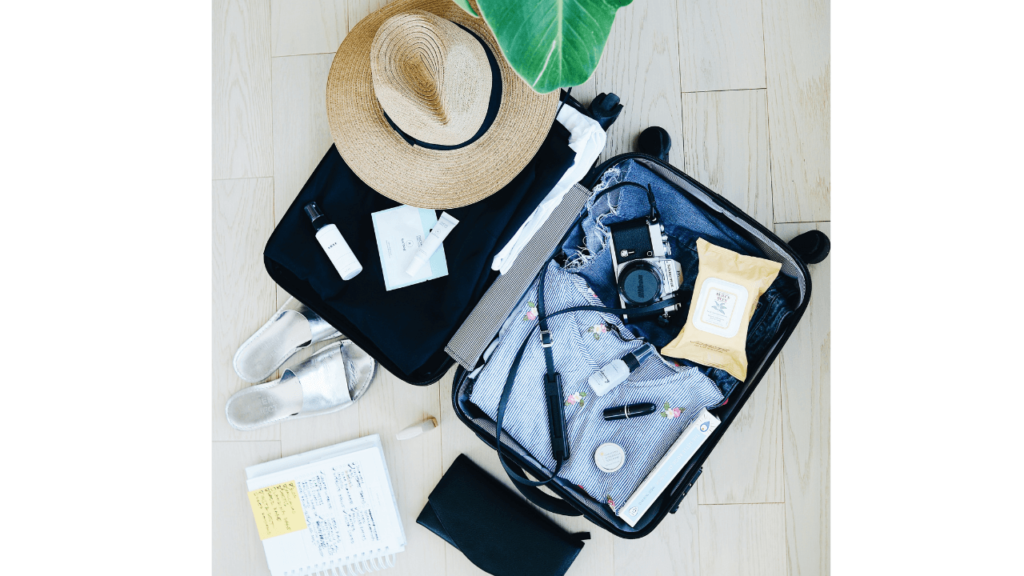
Footwear: Comfortable walking shoes for temple visits and sandals or flip-flops for onboard relaxation.
Sun Protection: Sunscreen, sunglasses, a wide-brimmed hat, and a lightweight scarf or shawl.
Medication: Any personal medications, a basic first-aid kit, motion sickness tablets (just in case), and insect repellent.
Documentation: Passport, cruise tickets, travel insurance details, and any necessary visas.
Toiletries: While many cruises offer basic amenities, pack your essentials. Remember, having a small travel-sized kit for off-boat excursions is a good idea.
Miscellaneous: A compact daypack, a camera (with extra batteries or charger), a notebook or journal, and binoculars for bird watching.
Electrical Considerations
Voltage: Egypt operates on 220 volts, 50 Hz. Ensure your devices are compatible, or bring a voltage converter.
Plug Types: Egypt’s most common plug types are Types C and F. They have two round pins, similar to many European countries.
Traveler’s Tip: A universal travel adapter is a worthy investment, ensuring you can charge your devices anywhere you travel.
Additional Considerations
Cultural Respect: While Egypt is modernizing, it’s essential to dress modestly, especially during shore excursions. Women should consider packing skirts or dresses that go below the knee and tops that cover the shoulders.
Swimwear: Some cruises have pools or offer opportunities to swim, so don’t forget your swimsuit.
Snacks: If you have specific dietary needs or enjoy particular snacks, it’s a good idea to pack some.
Packing for a Nile Cruise is a blend of preparation and anticipation. By considering the essentials, electrical needs, and sustainability, you’re ensuring a journey that’s as seamless as it is unforgettable.
Read about things to do and don’t in Egypt before going on a journey!
How to choose the right Nile Cruise
Selecting the perfect Nile Cruise can be an exciting yet daunting task. With various options and factors to consider, one needs to strike a balance between preferences, budget, and desired experiences. Below is a comprehensive guide to aid you in making the best choice:
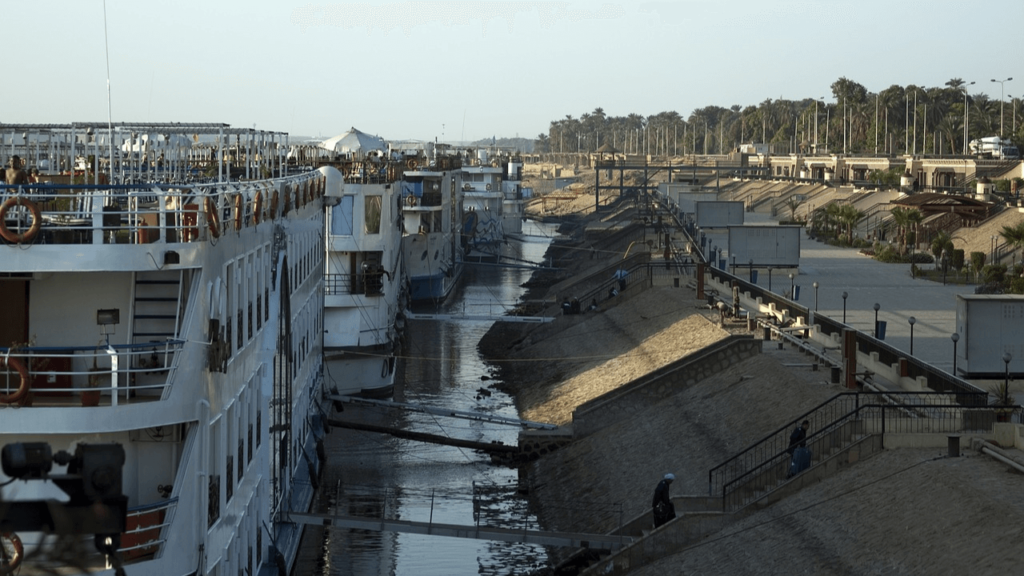
Type of Vessel
The Nile boasts a diverse array of boats, from the quaint charm of traditional feluccas and Dahabiyas to the grandeur of standard and luxury cruisers. The vessel you choose can significantly dictate the ambiance of your journey.
Onboard Amenities
Amenities can greatly enhance your cruising experience. Prioritize what’s essential for you, be it a swimming pool, spa, gym, entertainment shows, or enlightening lectures about Egypt’s rich history.
Cabin Quality
Your cabin is your sanctuary. Whether you prioritize a pristine, basic cabin or crave the opulence of a suite with Nile views, ensure it aligns with your comfort needs.
Included Excursions
Investigate the excursions included in the package. While some cruises incorporate guided temple visits, others might charge extra. Determine if you prefer a structured itinerary or the flexibility to choose.
Dining Options
Egyptian cuisine is rich and varied. Ensure the cruise offers a culinary experience that matches your palate, from diverse menus to dishes catering to specific dietary needs.
Group Size
The vessel’s size often dictates group dynamics. A smaller boat can provide a more intimate and personalized experience, while larger ones might offer more amenities and activities.
Language Considerations
Communication is vital. Ensure the crew and guides are proficient in a language you’re comfortable with, whether it’s your native tongue or English.
Environmental Considerations
Eco-conscious travelers might want to opt for cruises that employ sustainable practices, ensuring the Nile’s preservation for generations to come.
Cultural Activities
For a deeper dive into Egyptian culture, select cruises that offer immersive activities, from traditional music evenings to belly dancing performances and culinary classes.
Feedback and Recommendations
Reviews and personal recommendations can be invaluable. They offer insights into aspects you might overlook and provide real-life feedback on the cruise experience.
Budget
This underpins many choices. Ensure you’re getting value for your money by considering all inclusions, from meals and excursions to tips and additional fees.

Duration
Depending on your schedule, decide if a shorter cruise (3-4 days) suits you or if you’d prefer a longer, more in-depth journey (7-8 days).
Safety and Health
Given the times, some travelers prioritize cruises with stringent health and safety protocols, from regular sanitization to onboard medical facilities.
Departure Points
The start and end points (typically Luxor and Aswan) can influence your travel plans in Egypt. Ensure the cruise’s itinerary aligns with your overall trip.
Tips for Cruising the Nile River
Embarking on a Nile River cruise is a unique adventure, allowing travelers to delve into Egypt’s ancient history while taking in its breathtaking landscapes. To ensure a smooth and memorable experience, consider the following tips:
Research and Plan Ahead
Booking in advance often secures better rates and guarantees availability, especially during peak seasons.
Dress Appropriately
Egypt is predominantly Muslim; hence, dressing modestly is advisable, especially when visiting religious sites. Light, breathable clothes are best for the daytime, with a sweater or jacket for cooler evenings.
Wear comfortable walking shoes for excursions, as many historical sites involve uneven terrains.
Stay Hydrated and Protected
The Egyptian sun can be intense. Drink plenty of water, wear a hat, apply sunscreen, and use sunglasses to shield your eyes.
Be Culturally Sensitive
Always ask for permission before photographing locals. Familiarize yourself with basic local customs and etiquette to foster positive interactions.
Manage Your Budget
While many expenses are covered in your cruise package, set aside a budget for additional excursions, souvenirs, and personal needs.
Tipping is Customary
Tipping (or “baksheesh”) is customary in Egypt. Keep small changes for tipping guides, drivers, and cruise staff. Familiarize yourself with appropriate tipping amounts for various services.
Stay Connected
Internet connectivity can be intermittent on the Nile. If staying connected is vital, consider purchasing a local SIM card or a portable Wi-Fi device.

Be Prepared for High and Low Dam Crossings
If your cruise itinerary involves crossing the Aswan High or Low Dam, be prepared for potential delays or schedule adjustments.
Maintain Flexibility
Sometimes, unforeseen changes can occur in itineraries due to weather or other factors. Embrace the experience and make the most of every moment.
What to Expect on a Nile Cruise: A Journey Through Experience
A Nile Cruise is more than just a trip; it’s an experiential dive into history, landscapes, and cultural immersion. Here’s a taste of what you can expect based on shared experiences from past travelers:
Historical Wonders
At every bend of the river, relics of ancient civilizations beckon. From the grandeur of Luxor’s Valley of the Kings to the intricate details of temples at Edfu and Kom Ombo, the echoes of ancient pharaohs, deities, and legends are palpable.
Picturesque Sunsets
Many travelers recount the sheer magic of watching the sunset over the Nile, with the horizon painted orange, pink, and purple hues reflecting upon the calm waters and palm-fringed banks.
Local Encounters
Floating past small villages, children often wave enthusiastically from the shores. Some cruises offer stops at local markets or villages, where travelers get a glimpse into everyday Egyptian life.
Delicious Cuisine
Onboard, expect a fusion of traditional Egyptian dishes and international fare. Many travelers fondly recall their first taste of molokhia (a rich green soup) or freshly baked Egyptian bread.

Cultural Entertainment
Nights come alive with traditional music, belly dance performances, and galabeya parties where guests can don traditional Egyptian attire.
Peaceful Mornings
The gentle hum of the cruise ship, the chirping of birds, and the sight of fishermen casting their nets at dawn provide a tranquil start to the day.
Guided Explorations
Experienced guides breathe life into stone carvings and hieroglyphs, transporting travelers back in time. Their anecdotes, historical insights, and cultural explanations are often a highlight for many.
Comfort and Luxury
Depending on the cruise chosen, travelers speak of the pampering they receive—spacious cabins, sun decks, pools, and even spas that make the journey a blend of exploration and relaxation.
Nile Cruise is a tapestry of vivid experiences, a harmonious blend of the old and the new. It’s where memories are crafted, stories of ancient civilizations unfold, and the timeless beauty of Egypt is celebrated at every ripple.
Final words
Embark on an unforgettable voyage along the world’s longest river with our comprehensive Nile Cruise Guide. The Nile isn’t just a waterway; it’s a timeless testament to Egypt’s rich tapestry of history, culture, and breathtaking landscapes. From the architectural marvels of Luxor’s temples to the mesmerizing beauty of Aswan’s cataracts, a Nile cruise offers a window into the heart of ancient civilizations. Whether you’re seeking the opulence of luxury cruisers or the authenticity of traditional feluccas, our guide ensures you make an informed choice tailored to your interests. Delve into essential tips on the best travel seasons, onboard amenities, key attractions, and cultural etiquette. As the sun sets over the Nile, painting golden hues on its tranquil waters, you’ll realize this isn’t just a journey—it’s a step back in time. Equip yourself with our expert insights, and let the majestic Nile narrate tales that have shaped humanity. Dive into our Nile Cruise Guide and prepare for a voyage.

